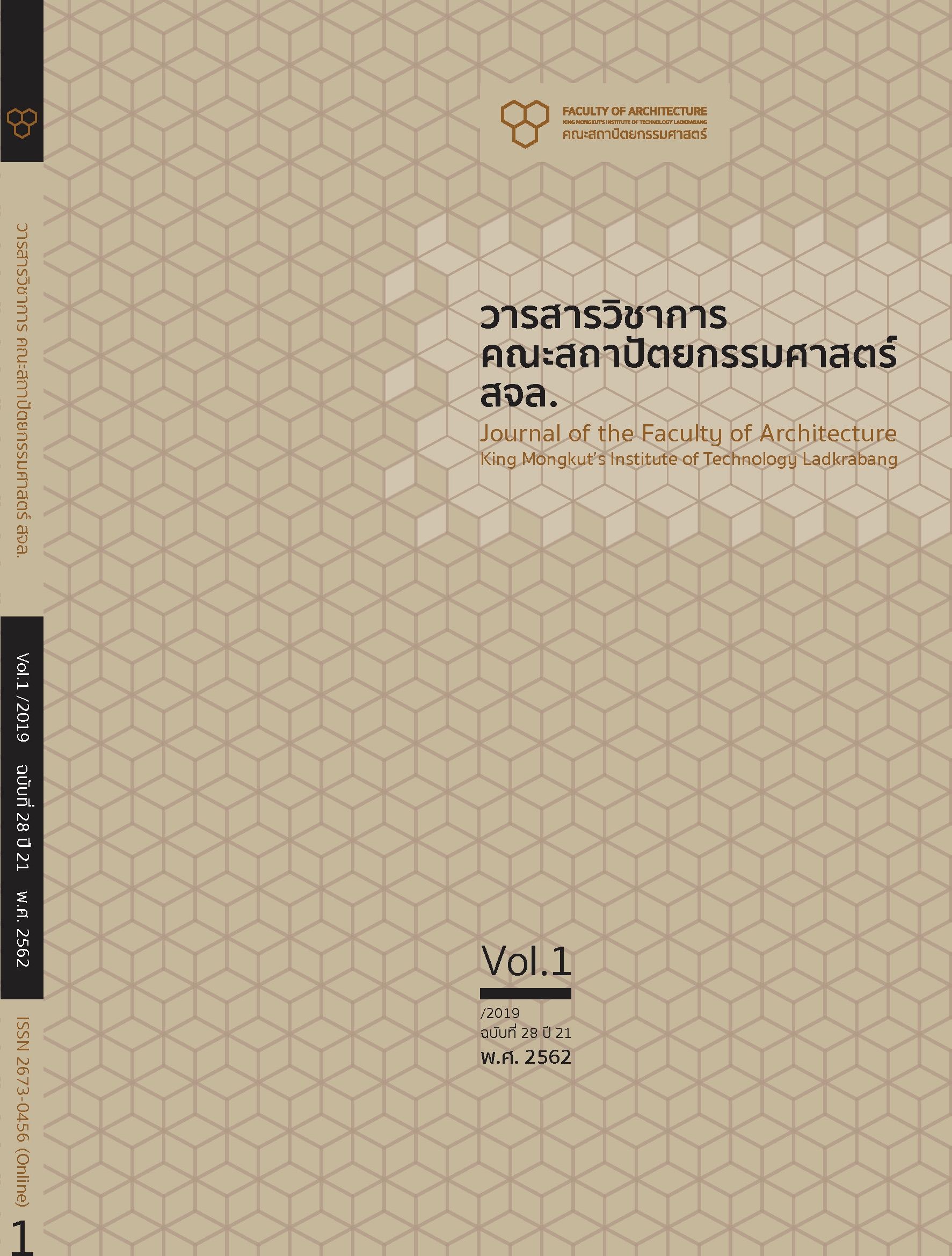The Impact Assessment of Climate Changes toward People’s Healthy in Bangkok Metropolis
Main Article Content
Abstract
บทคัดย่อ
การเปลี่ยนแปลงสภาพภูมิอากาศมีผลต่อสุขภาพของมนุษย์แต่ยังยากต่อการประเมินระดับของผลกระทบที่มีความแตกต่างกันในระดับชุมชน บทความนี้จึงพัฒนากรอบการประเมินระดับผลกระทบจากการพิจารณาปัจจัยสองกลุ่มหลักคือปัจจัยที่ส่งผลกระทบต่อสุขภาพของชุมชน ได้แก่ 1) ภาวะความเจ็บป่วยสัมพันธ์กับสภาวะอากาศ 2) ความอ่อนไหวต่อสภาวะอากาศ และ 3) ความเสี่ยงต่อสภาวะอากาศ และปัจจัยด้านศักยภาพชุมชนในการรับมือกับสภาวะภูมิอากาศ ได้แก่ 1) ลักษณะทางกายภาพ สังคม เศรษฐกิจ 2) มาตรการบรรเทาผลกระทบจากสภาวะภูมิอากาศ จากการสำรวจ และเก็บแบบสอบถามกลุ่มตัวอย่าง 370 คน ในชุมชน 5 ประเภทที่อยู่ในกรุงเทพฯ ได้ แก่ ชุมชนแออัดชุมชนบ้านแถว ชุมชน บ้านเดี่ยว คอนโดมิเนียมระดับกลาง และคอนโดมิเนียมระดับสูง โดยกรอบการประเมินแบ่งออกเป็น 3 ระดับ คือ <1 มีความสามารถรับมือมากกว่าผลกระทบที่ได้รับ= 1 มีความสามารถรับมือเท่ากับผลกระทบที่ได้รับและ >1 มีความสามารถรับมือน้อยกว่าผลกระทบที่ได้รับผลการศึกษาพบว่าชุมชนทั้ง5 ประเภท มีค่าระดับผลกระทบต่อสุขภาพจากสภาพ ภูมิอากาศในระดับที่น้อยกว่า 1 หมายความว่า ชุมชนมีความสามารถในการบรรเทาผลกระทบต่อสุขภาพมากกว่าผลกระทบที่ได้รับโดยชุมชนมัสยิสมหานาค (ชุมชนแออัด) มีค่าเท่ากับ 0.72 ส่วนชุมชนตรอกขุนนาวา (ชุมชนบ้านแถว) มีค่าเท่ากับ 0.75 ชุมชนนครไทย (ชุมชนบ้านเดี่ยว) ชุมชนลุมพินีเพลส (คอนโดมิเนียมระดับกลาง) และชุมชนโนเบิลไลท์ (คอนโดมิเนียมระดับสูง) มีค่าเท่ากับ 0.63 0.62 และ 0.58 ตามลำดับโดยชุมชนแออัดและชุมชนบ้านแถวมีความสามารถในการรับมือผลกระทบต่อสุขภาพจากสภาพภูมิอากาศต่ำกว่าชุมชนบ้านเดี่ยวและชุมชนคอนโดมิเนียม อย่างไรก็ตามค่าระดับผลกระทบของชุมชนเป็นค่าค่อนข้างเข้าใกล้ 1 แสดงถึงชุมชนในกรุงเทพฯ มี โอกาสได้รับผลกระทบต่อสุขภาพจาก การเปลี่ยนแปลงสภาพภูมิอากาศได้ตลอดเวลา
คำสำคัญ: การเปลี่ยนแปลงสภาพภูมิอากาศ สุขภาพของมนุษย์ ชุมชนเมือง
Abstract
The climate changes have had an impact on human health; however, it has been unapparent measures for assessing its influenced levels different in a given community. This study focuses on developing a framework for human health impact assessment derived from the climate change. There were 2 major groups of factors including community’s health and community’s ability in dealing with impact of climate change. The first group comprises 1) situation of community’s illness relating to climate situations, 2) community’s vulnerability to climate situations, and 3) community’s risk to climate situations. The latter group considered 1) physical social and economic aspects of communities, and 2) existing mitigating measures on climate situations of communities. According to field surveying with questionnaires of 370 persons in 5 different types of Bangkok’s community; including 1) slum community, 2) row house, 3) single detached house, 4) the medium class condominium, and 5) the high-end condominium, and the measurement framework of health impact assessment, there were 3 levels of assessment including 1) <1 show ability of communities in coping with climate change being higher than its impact levels, 2) =1 show ability of communities in coping with climate change being equal to its impact levels, and 3) <1 show ability of communities in coping with climate change being lower than its impact levels. The results can explained that Bangkok’s community have had levels of impact of climate change in lower than 1. This means that in general the communities can cope with the impact of climate change. If individual community types were considered, slum community and row house showed the health impact assessment value with 0.72 and 0.75. while single detached house, the medium class condominium, and the high-end condominium had health impact assessment values with 0. 63, 0. 62, and 0. 58 respectively. This implies that the slum community and the row house have high risk in encountering with the impact of climate change as they have health impact assessment values approaching to 1.
Keywords: Climate Change, Human Health, Urban Community
Article Details
This work is licensed under a Creative Commons Attribution-NonCommercial-ShareAlike 4.0 International License.
Copyright Transfer Statement
The copyright of this article is transferred to Journal of The Faculty of Architecture King Mongkut's Institute of Technology Ladkrabang with effect if and when the article is accepted for publication. The copyright transfer covers the exclusive right to reproduce and distribute the article, including reprints, translations, photographic reproductions, electronic form (offline, online) or any other reproductions of similar nature.
The author warrants that this contribution is original and that he/she has full power to make this grant. The author signs for and accepts responsibility for releasing this material on behalf of any and all co-authors.
References
กรมอุตุนิยมวิทยา. (2551). จำนวนวันที่มีอุณหภูมิสูงเกิน 35 องศาเซลเซียส. เข้าถึงได้จาก: https://www.tmd.go.th/province_stat.php.
กรมอุตุนิยมวิทยา. (2554). อุณหภูมิ ปริมาณน้ำฝน และความเร็วลม. กรุงเทพฯ: กรมอุตุนิยมวิทยา.
ศูนย์อำนวยการบรรเทาสาธารณภัย. (2555). การเกิดวาตภัยในประเทศไทย ระหว่างปี พ.ศ. 2532-2553. กรุงเทพฯ: กรมป้องกันและบรรเทาสาธารณะภัย.
สำนักการแพทย์. (2555). สถิติการเจ็บป่วย. กรุงเทพฯ สำนักการแพทย์.
สำนักการระบายน้ำ. (2555). ระดับน้ำทะเลสูงสุด ระดับน้ำเจ้าพระยาสูงสุด และปริมาณการระบายน้ำปี พ.ศ. 2538-2554. กรุงเทพฯ: สำนักการระบายน้ำ กรุงเทพมหานคร.กรมป้องกันและบรรเทาสาธารณภัย.
สำนักงานนโยบายและแผนทรัพยากรธรรมชาติและสิ่งแวดล้อม. (2552). แผนแม่บทรองรับการเปลี่ยนแปลงสภาพภูมิอากาศแห่งชาติ พ.ศ. 2553-2562. กรุงเทพฯ: สำนักงานนโยบายและแผนทรัพยากรธรรมชาติและสิ่งแวดล้อม กระทรวงทรัพยากรธรรมชาติและสิ่งแวดล้อม.
สำนักพัฒนาอุตุนิยมวิทยา. (2555). พายุหมุนเขตร้อนที่เคลื่อนที่เข้าสู่ประเทศไทยในขณะที่มีกำลังแรงเป็นพายุโซนร้อน และไต้ฝุ่น ในรอบ 61 ปี (พ.ศ. 2494-2554). กรุงเทพฯ: กรมอุตุนิยมวิทยา.
BBC NEWS. (2007). Science/Nature, Billions Face Climate Change Risk. Retrieved from: https://newsvote.bbc.co.uk/2/hi/science/nature/653223.stm.
BMA, UNEP, และ Green Leaf. (2009). รายงานการประเมินกรุงเทพมหานครว่าด้วยการเปลี่ยนแปลงสภาพภูมิอากาศ พ.ศ. 2552. Retrieved from:https://office.bangkok.go.th/environment/pdf/bangkok-th.pdf.
De, U.S., Dube, R.K. and Rao, G.P. (2005). Extreme Weather Events Over India in the Last 100 Years. Journal of the Indian Geophysical Union. 9(3), 173-187.
Haines, A., and Patz, J. (2004). Health Effects of Climate Change. J. Am Med Assoc. 291(1), 99-103.
Haines, A., Kovats, R.S., Campbell-Lendrum, D., and Corvalan, C. (2006). Climate Change and Human Health: Impacts, Vulnerability and Public Health. Public Health. 120(7), 585-596.
IPCC. (2001). Climate Change 2001: Synthesis Report. A Contribution of Working Groups I, II and III to the Third Assessment Report of the Intergovernmental Panel on Climate Change. Cambridge and New York: Cambridge University Press.
Masters, J. (2007). The Landmark 2007 IPCC Report on Climate Change. Weather Underground. Retrieved from: https://www.wunderground.com/resources/climate/ipcc2007.asp.
Montavez, J. P., Rodriguez, A. and Jimenez, J. I. (2000). A Study of the Urban Heat Island of Granada. International Journal of Climatology. 20(8), 899-911.
NRDC. (2008). Preparing for Global Warming: A Framework for Protecting Community Health and the Environment in a Warmer World, Health Facts. Retrieved from: https://www.nrdc.org/sites/default/files/preparedness.pdf.
Oke, T. R. (1987). Boundary Layer Climates. New York: Routledge.
Stern, N. (2007). The Economics of Climate Change: The Stern Review. Cambridge: CUP.
Tereshchenko, I. E., and Filonov, A. E. (2001). Air Temperature Fluctuations in Guadalajara, Mexico, from 1926 to 1994 in Relation to Urban Growth, International Journal of Climatology. 21(4), 483-494.
WHO. (2006). Health and Environment Linkages Initiative. Retrieved from: https://www.who.int/heli/en/.
WHO. (2009). Protecting Health from Climate Change Connecting Science, Policy and People. Retrieved from: https://apps.who.int/iris/bitstream/handle/10665/44246/9789241598880_eng.pdf: jsessionid=6D9A656060F3F080935B6F5CECEFB3D5?sequence=1.
Yague, C., Zurita, E. and Martinez, A. (1991). Statistical-Analysis of the Madrid Urban Heat-Island. Atmospheric Environment Part B-Urban Atmosphere. 25(3), 327-332.
Yamane, T. (1973). Statistics: An Introductory Analysis. 3rd. New York: Harper and Row.

